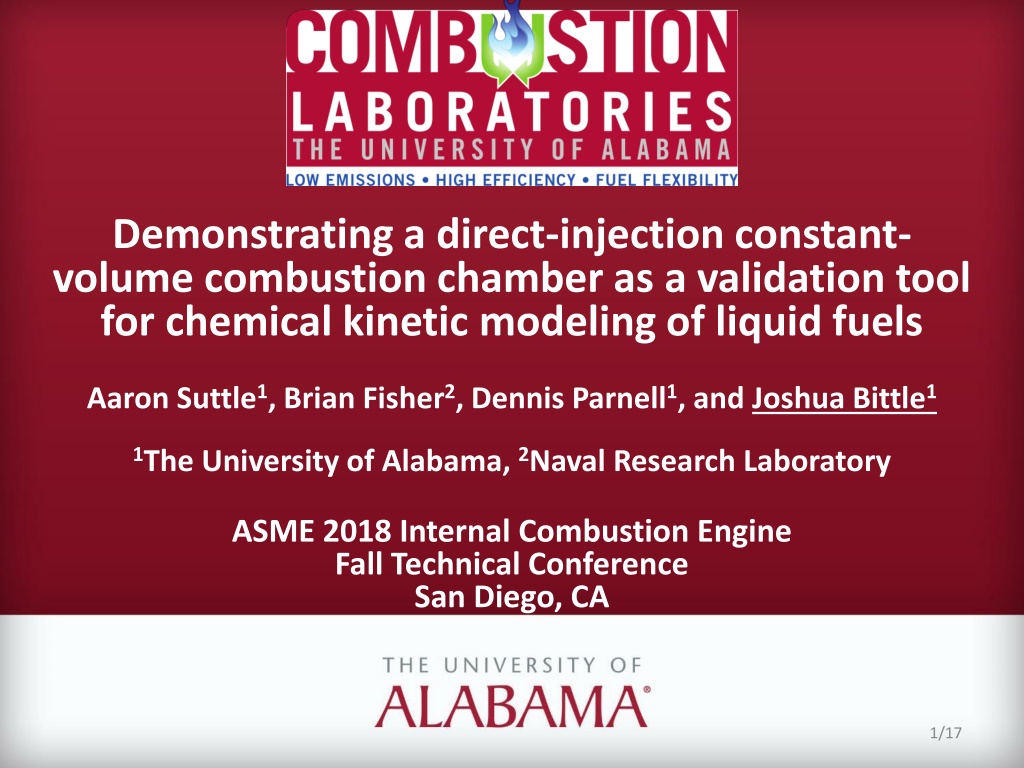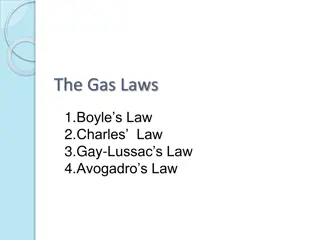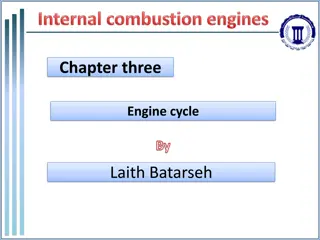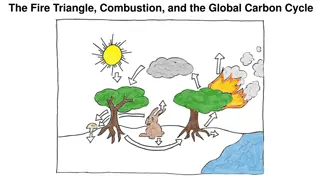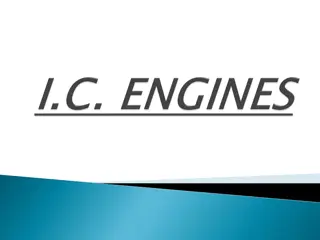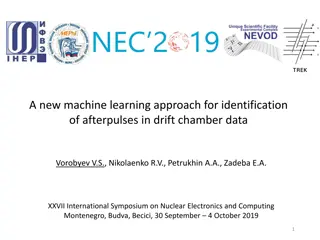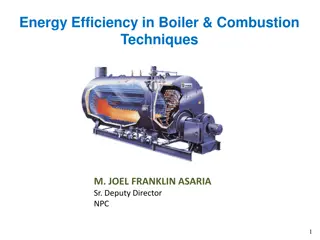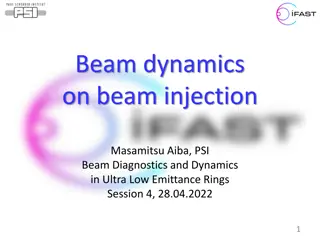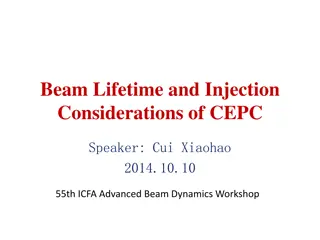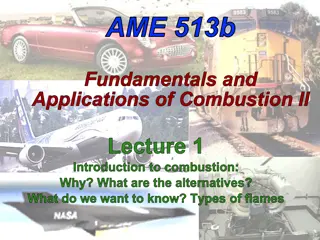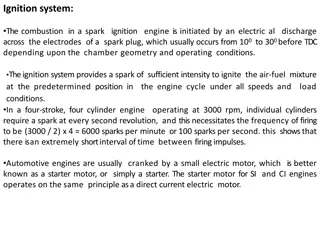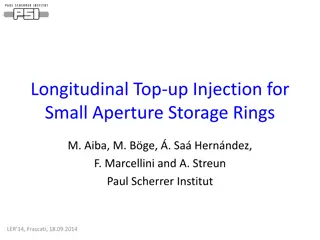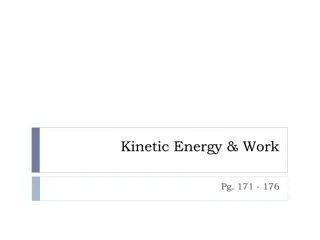Direct-Injection Constant-Volume Combustion Chamber for Chemical Kinetic Modeling
This study validates chemical kinetic models of liquid fuels using a direct-injection constant-volume combustion chamber. The research explores ignition research techniques, experimental setups, and data processing for mechanism development. Project motivation focuses on studying combustion of low volatility fuels and improving understanding of combustion phenomena. Advanced devices like the Derived Cetane Tester are utilized to address challenges in fuel injection processes and mixture temperature control.
Download Presentation

Please find below an Image/Link to download the presentation.
The content on the website is provided AS IS for your information and personal use only. It may not be sold, licensed, or shared on other websites without obtaining consent from the author. Download presentation by click this link. If you encounter any issues during the download, it is possible that the publisher has removed the file from their server.
E N D
Presentation Transcript
Demonstrating a direct-injection constant- volume combustion chamber as a validation tool for chemical kinetic modeling of liquid fuels Aaron Suttle1, Brian Fisher2, Dennis Parnell1, and Joshua Bittle1 1The University of Alabama, 2Naval Research Laboratory ASME 2018 Internal Combustion Engine Fall Technical Conference San Diego, CA 1/17
Presentation Overview Ignition Research Techniques Background Motivation Experimental Setup and Modifications Data Processing and Test Plan Results Summary and Future work 2/17
Ignition Research Techniques Computationally based combustion research utilizes chemical-kinetic mechanisms to model the complex chemical reactions and the combustion phenomena Experimentally based studies use a variety of devices: Rapid Compression Machines (RCM) Shock Tubes Constant Volume Combustion Chambers (CVCC)-The ignition quality tester (IQT) and derived cetane tester (CID) Combustion occurring within each of these devices is then captured via combustion pressure transducers or optical ports In order to facilitate mechanism development, each system would be approximated as a perfect stirred reactor 3/17
Ignition Research Techniques - CVCC When using a CVCC considerations must be made, which form limitations on the device s capabilities 1. Due to the transient nature of the fuel injection process, there exists a time below which, the chamber cannot be considered well mixed 2. Accurate measurement of thermodynamic state of contained air mass for estimation of initial conditions and global equivalence ratio is critical 3. Accurate characterization and control of the fuel injection system is of utmost importance for limiting uncertainty associated with the fuel injection process 4/17
Project Motivation and Background Combustion of liquid fuels is often studied for the validation or refinement of chemical-kinetic mechanisms A particular difficulty for traditional combustion test apparatuses are low volatility fuels These fuels can be difficult to evaporate, and maintain in a vapor state prior to mixing with air and increasing mixture temperature The Derived Cetane Tester (CID 510) addresses this by injecting liquid fuel into a heated, high pressure constant volume combustion chamber by utilizing a commercial diesel engine injector High Pressure Fuel Supply and Transducer Injector Combustion Chamber Combustion Pressure Transducer Gas Supply 5/17
Experimental Setup and Modifications Beginning with the unmodified CID, an external control and DAQ system was developed to expand the chambers range of testable temperatures, pressures, and equivalence ratios 6/17
Device Characterization After completing expansion of the CID controls, the various processes related to the device s accuracy were characterized These included: Chamber wall temperature offset and temperature spatial homogeneity Volume of injected fuel calibration Effects of evaporative cooling Calibration of all onboard pressure transducers 7/17
Initial Results ,T sweeps n-heptane Pamb = 5 bar iso-octane Pamb = 20 bar Based on confidence in thermodynamic state and injection durations, a minimum threshold ignition delay of 10 ms results in a kinetics dominated ignition event that can reasonably be compared to a 0-D model. 10/17
Initial Results ,T sweeps Why would n-heptane have better agreement with model than iso-octane at nominally same ignition delay range? n-heptane Pamb = 5 bar iso-octane Pamb = 20 bar Next step: try to study pressure effects Must use iso-octane due to ign range 11/17
Octane Pressure Sweep Relative pressure effects are captured Extremes of NTC region are not and only low P cases show reversal in ign Capturing pressure dependence is a focus of kinetic model developers. In this case the dependence is over predicted. 12/17
Bulk Temperature Histories iso-octane Pamb = 5 bar Process pressure histories into bulk temperature assuming ideal gas and constant gas constant* Plotted range of 600-1200 K highlights low-temp. regime Apparent low-temp kinetics barrier around 800 K. Correlation between temp. increase during 1st stage and secondary delay to main ignition. *during the 1st stage reactions the bulk gas constant does not change much and will not affect trends. 13/17
Bulk Temperature Histories iso-octane Pamb = 15 bar Same observations, except no reversal in main ignition delay trend. Apparent low-temp kinetics barrier around 825 K in this case. This barrier tends to slow the overall ignition process for temperatures in the NTC region. For Tamb>850 K, 1st stage begins before 10 ms threshold. *during the 1st stage reactions the bulk gas constant does not change much and will not affect trends. 14/17
Connection of 1st to 2nd Delay iso-octane Results suggest concentrations of main ignition precursors (e.g. H2O2) after 1st stage is proportional with 1st statge heat release ( T) Increase in initial temp reduces 1st stage HR and thus more time is needed for accumulation of precursors before main ignition. Above the kinetic barrier, 1st stage kinetics still present, but precursor accumulation is primarily through other pathways. 15/17
Comparison With Other Devices Work While not included in paper, the key difference is that CID, IQT, RCM all show suppressed NTC behavior compared to model and shock tubes. n-heptane 3-4.5 bar CID to RCM iso-octane 15 bar CID to shocktube 16/17
Summary and Conclusions The modified CID is a capable ignition delay test apparatus based on extensive characterization of thermodynamic state. Under conditions with more than 10 ms ignition delay the results may be reasonably compared to 0-D simulations. Temperature profiles highlight interesting NTC behavior and illustrate low-temperature kinetic barriers. Comparing CID and other apparatus to models suggest over prediction of sensitivity to pressure (at least in context of internal combustion engines). 17/17
Thank you for your attention! 18
Chamber Temperature Offset Chamber temperature offset was measured at 9 temperature and pressure conditions The plot below was used to curve fit a surface equation for the purpose of estimating total wall temperature offset 19/17
